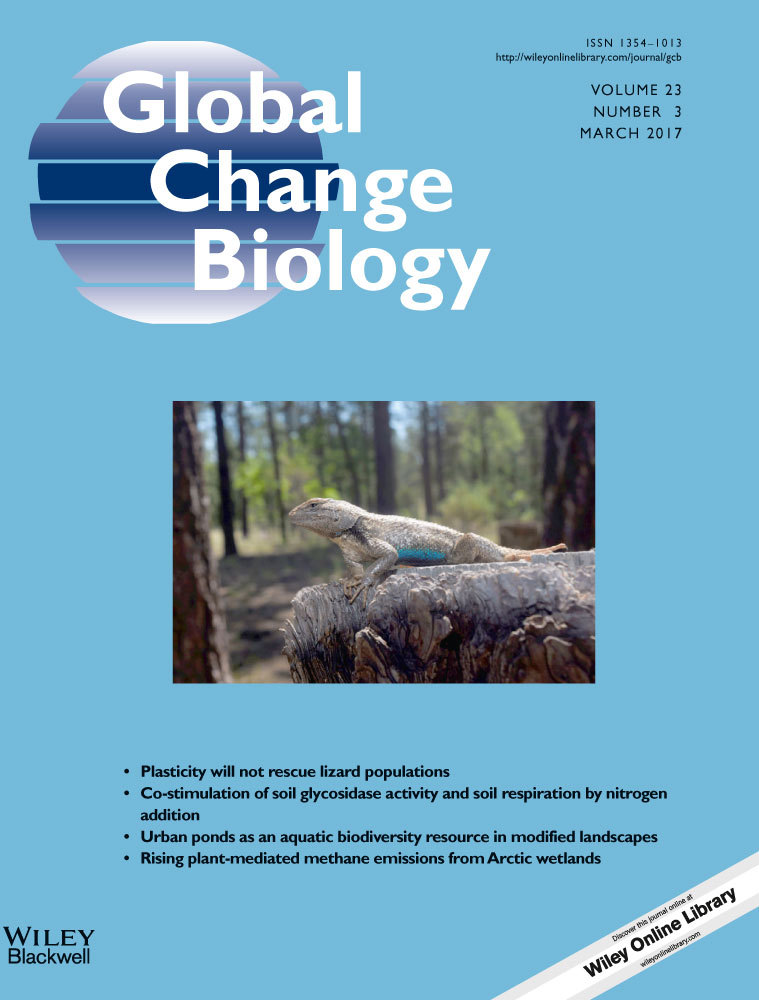Spatial and temporal dimensions of fire activity in the fire-prone eastern Canadian taiga
Abstract
The forest age mosaic is a fundamental attribute of the North American boreal forest. Given that fires are generally lethal to trees, the time since last fire largely determines the composition and structure of forest stands and landscapes. Although the spatiotemporal dynamics of such mosaics has long been assumed to be random under the overwhelming influence of severe fire weather, no long-term reconstruction of mosaic dynamics has been performed from direct field evidence. In this study, we use fire length as a proxy for fire extent across the fire-prone eastern Canadian taiga and systematically reconstruct the spatiotemporal variability of fire extent and fire intervals, as well as the resulting forest age along a 340-km transect for the 1840–2013 time period. Our results indicate an extremely active fire regime over the last two centuries, with an overall burn rate of 2.1% of the land area yr−1, mainly triggered by seasonal anomalies of high temperature and severe drought. However, the rejuvenation of the age mosaic was strongly patterned in space and time due to the intrinsically lower burn rates in wetland-dominated areas and, more importantly, to the much-reduced likelihood of burning of stands up to 50 years postfire. An extremely high burn rate of ~5% yr−1 would have characterized our study region during the last century in the absence of such fuel age effect. Although recent burn rates and fire sizes are within their range of variability of the last 175 years, a particularly severe weather event allowed a 2013 fire to spread across a large fire refuge, thus shifting the abundance of mature and old forest to a historic low. These results provide reference conditions to evaluate the significance and predict the spatiotemporal dynamics and impacts of the currently strengthening fire activity in the North American boreal forest.
Introduction
The North American boreal forest is strongly shaped by extensive and recurrent wildfires (Payette et al., 1989; Payette, 1992; Stocks et al., 2002; Boulanger et al., 2012). These fires occur under the compounded influence of several top-down and bottom-up drivers (Parisien et al., 2011; Cavard et al., 2015; Dash et al., 2016), such as ignition agents (Flannigan & Wotton, 1991), weather conditions before and during fire spread (Flannigan & Wotton, 2001; Wang et al., 2014), fuel composition and loading (Hély et al., 2010; Héon et al., 2014; Parisien et al., 2014), and landscape physiography (Mansuy et al., 2014). Because most fires are stand replacing (Rogers et al., 2015), boreal landscapes are structured as mosaics of large even-aged forest patches (White & Pickett, 1985). After burning, patches undergo a postfire trajectory of vegetation succession and biomass accumulation until complete or partial destruction by the subsequent fire (Brown & Johnstone, 2011). Consequently, the time since the last fire is an important attribute that determines forest composition and structure and carbon stocks at both stand and landscape levels (Bond-Lamberty et al., 2004, 2007; Taylor & Chen, 2011; Irulappa Pillai Vijayakumar et al., 2016).
Models suggest that the North American boreal forest will experience a generalized increase in burn rates (percent area burned annually) during the 21st century as a consequence of projected climatic changes (Flannigan et al., 2005; Balshi et al., 2009; Bergeron et al., 2011; Boulanger et al., 2014; Wang et al., 2015). Larger fires, on average, and more frequent large-fire years are predicted (Kasischke & Turetsky, 2006; Ali et al., 2012), with associated impacts on the spatial structure and functioning of the landscape age mosaic (Bond-Lamberty et al., 2007; Johnstone et al., 2011; Kettridge et al., 2015). Indeed, fire activity has already increased during the last 30 years in some areas of the boreal forest and adjacent tundra (Kasischke & Turetsky, 2006), a phenomenon that may have triggered shifts to more fire-prone and less-productive ecosystems, as well as to reduced carbon stocks (Lavoie & Sirois, 1998; Johnstone et al., 2010; Mack et al., 2011; Turetsky et al., 2011). In fact, the projected fire activity is unlikely to maintain forest cover in several of the most fire-prone areas, thereby causing a shift to woodland or nonforest vegetation (Westerling et al., 2011).
However, most projections of future fire activity are based on climate only and assume no negative feedback of stand age on fire activity (Flannigan et al., 2005; Balshi et al., 2009; Bergeron et al., 2011; Boulanger et al., 2014). Although fire activity has long been considered independent from forest age in the North American boreal forest (Bessie & Johnson, 1995), strong support for an age effect has recently emerged from the monitoring of fire perimeters (Parisien et al., 2014; Bernier et al., 2016; Dash et al., 2016), as well as from exhaustive datasets of fire overlaps over the last few centuries (Niklasson & Granström, 2000; Héon et al., 2014). This age effect has also been documented from various regions around the world, such as the western United States, Portugal, and Australia, although the intensity of this phenomenon varies with fire frequency (i.e., encounter rate between new and previous fires), forest types, and weather severity (Price & Bradstock, 2010; O'Donnell et al., 2011; Parks et al., 2015, 2016; Price et al., 2015). In the context of climate change, such an age effect would lead to landscape age mosaics with very different properties relative to the age-independent scenario (Fig. 1). First, because the likelihood of re-burning increases with stand age, the youngest fraction of the mosaic would reduce fire spread across the landscape and would buffer the predicted increase in burn rates. Second, because the age feedback spatially structures the likelihood of burning, the age effect would increase the predictability of fire occurrence across the mosaic. In theory, this buffering and enhanced predictability of the fire activity would increase with the strength of the age effect.
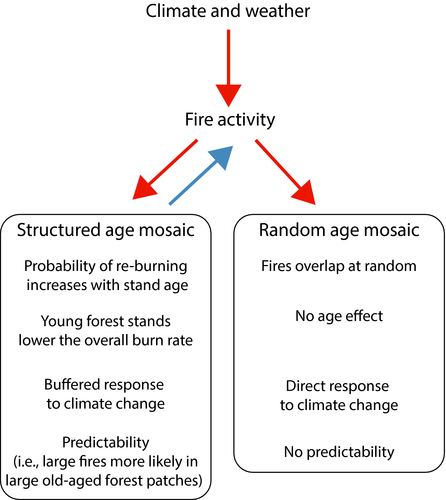
Yet, because stand-age mosaics are continuously reshaped, evaluating how actual landscapes diverge from the age independent scenario is challenging. Understanding the dynamics of landscape age mosaics requires systematic data on past fire sizes and fire intervals across an area larger that the largest possible fire over a time period longer that the mean fire interval, whereas most fire reconstructions document fire across either the temporal or the spatial dimension, but rarely both aspects. For example, charcoal analysis from sediments provides records of past fire intervals over millennia at given sampling points (Ali et al., 2012; Kelly et al., 2013; Oris et al., 2014) without direct measurement of fire size across space. Conversely, reconstructing the time since the last fire across space documents the size of the most recent fire events (Bergeron et al., 2004) without direct measurement on fire intervals through time.
To overcome the shortcoming or fire reconstructions not having both temporal and spatial depth, a method has been developed in which fire length is used as a proxy for fire extent. With this method, it has been possible to reconstruct past fire overlaps along a 190-km road transect across the fire-prone eastern Canadian taiga (Héon et al., 2014). This approach allowed a detailed depiction of both fire extents and associated fire intervals over the last two centuries and was used to document a negative feedback between stand age and the probability of burning. In this study, we expanded this dataset by sampling an additional 150 km to the south. The resulting 340-km transect covers a geographic gradient of increasing fire size, from south to north, as well as the last 175 years of fire activity (1840–2013) in a region characterized by rapid recent warming (0.5 °C increase in mean June–July temperature per decade since 1975; CRU TS 3.21 dataset; Harris et al., 2014).
The main goal of this study was to use the above-mentioned dataset to reconstruct the spatiotemporal variability of the stand age mosaic and investigate the effect of its main top-down and bottom-up drivers. Specifically, we evaluate to what extent the landscape age mosaic has diverged from the age-independent scenario in one of the most fire-prone areas of the North American boreal forest. In doing so, our study also addresses the following questions: (i) Have the burn rate and response to climate change been buffered by the stand-age feedback? (ii) Has the warming trend of the last 40 years led to unprecedented fire activity and novel forest-age mosaics in the context of the last two centuries? (iii) What is our ability to identify areas at high risk of burning across the mosaic? Results will provide reference conditions for evaluating fire impacts on ecosystems and infrastructures over the coming decades.
Materials and methods
Study area
The study transect spans 340 km along the Bay James Road (built in 1971–1972) from north (53°3′ N) to south (51°2′ N) around 77°3′ W (Fig. 2), in the Province of Quebec. This region is characterized by a succession of low hills and depressions, made of the gneissic and granitic rocks of the Canadian Precambrian Shield, and forms a regular plateau varying between 100 to 200 m above sea level (Stockwell et al., 1968). Numerous lakes and rivers compose a dense hydrographic network flowing to James Bay. Peatlands are abundant, covering about 10–20% of the landscape. The climate is low subarctic with a mean annual air temperature varying between −3.1 °C and −2.4 °C from north to south, the coldest and the warmest months being January and July, respectively. The average annual precipitation is 683 mm, 40% of which falls as snow between October and May (Environnement Canada, 2016).
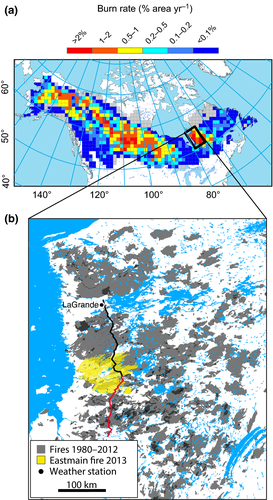
The region experiences one of the most active fire regimes and some of the largest recorded fires of the North American boreal forest. Burn rates have averaged 2.4% of the land area per year over the last century, and fires larger than 90 km in length have recurred every 20–30 years (Boulanger et al., 2013; Héon et al., 2014). Detailed fire perimeters of the last 35 years indicate that fire sizes increase from south to north, to the point where the northern half of our sampling transect intersects two of the three largest fires recorded in Canada over the 1980–2013 period (Fig. 2), including the 2013 Eastmain fire (5830 km2).
The fire season spans from May to September, although most fires occur in June and July. Wildfires are mostly ignited by lightning and there is virtually no fire suppression beyond the immediate vicinity of municipalities and hydroelectric facilities, nor is there any logging or agriculture, allowing us to document a largely natural fire regime. Human ignitions have been responsible for less than 3% of the total area burned since 1973 (Canadian Forest Service, 2016). Black spruce (Picea mariana (Mill.) B.S.P.) and jack pine (Pinus banksiana Lamb.) dominate the landscape. Both species are fire adapted and regenerate quickly after fire from aerial seedbanks stored in their serotinous cones (St-Pierre et al., 1992; Sirois, 1995). Eastern larch (Larix laricina (Du Roi) K. Koch) is frequent but rarely dominant. Broadleaved taxa are rare, covering less than 5% of the landscape.
Field sampling
Even if North American boreal fires are generally stand replacing, numerous surviving trees develop fire scars at the margin of unburned forest patches or within less severely burned areas. Thus, by systemically sampling fire scars and establishment dates of trees into a series of contiguous and sufficiently large cells along a road transect, it is possible to reconstruct the length intersected by each fire that spread across the transect (hereafter ‘fire length’) during the last two centuries (Héon et al., 2014). In their study, Héon et al. (2014) sampled 93 cells of ~2 × 1 km along a 193-km transect between the Eastmain and La Grande rivers along the James Bay road. Using the same method, we extended this transect by an additional 150 km, thus sampling 75 new 2-km2 cells (Fig. 2).
Within each cell, we exhaustively surveyed areas of potentially low rate of fire spread (stream, lake, and peatland margins; rocky outcrops; topographic breaks; uneven or open forest stands) to sample fire scars and establishment date of trees (trunk cross section) on live trees, snags, or woody debris. Large stems with multiple scars were always preferred over isolated scars as they are more likely to record short fire intervals. We also systematically favored jack pine over black spruce or eastern larch stems due to its more rapid postfire regeneration, faster juvenile height growth, and its proneness to develop multiple scars. Tree stems were sampled into each cell (average of 13 stems per cell) with the goal of obtaining duplicates of as many different fire dates as possible over the last two centuries. In order to optimize sampling, fire intervals were estimated in the field from tree ring counts on stems cross sections; each sample suggesting a new fire date was brought to the laboratory, whereas those indicating an already duplicated fire date were disregarded. For each sample, we recorded the species, the sampling height, stem type (living, snag, woody debris), stump type (attached to the trunk or not), and GPS location.
A ~20-km section in the center of the transect (km 220–240) was occupied by old black spruce stands (>300–400 years old) with rare or absent jack pine trees and few or no fire scars. In this section, three dominant black spruce stems were sampled at the root collar on at least two hilltops in each cell to estimate minimum stand age. This strategy was also applied locally between km 294–302 and km 316–340 of the transect (Fig. S1) to reconstruct 19th-century fires because these two sections comprised only relatively recent (>1835 and >1900, respectively) jack pine material.
In the laboratory, each cross section was finely sanded so that tree rings and fire scars could be distinguished under a dissecting microscope. We dated fire scars from living trees by counting tree rings from the sampling year, considering also diagnostic light rings as a validation tool. Scars from dead trees and from trees with suppressed growth sequences were first crossdated from a master chronology. Ring widths were measured and crossdated using Past4 (SCIEM, 2011) and COFECHA (Holmes, 1983). Fire dates were also deduced from establishment dates of live or dead pine trees that contained a trunk cross section with pith at a sampling height of less than one meter on stems with an attached stump. Following Héon et al. (2014), the establishment date at root collar was estimated from the first tree ring at sampling height, after adding a correction for the time lag between these two levels: C = 0.1154 H, where C is the correction (years) as a function of the sampling height H (cm).
Data analysis
We applied some rules to reconstruct the sequence of fire years into each sampling cell (Fig. S1). First, each fire date had to be replicated by at least one scar or one corrected establishment date from the same cell or from one of the two adjacent cells. Fire years from establishment dates and scars were assigned to the same fire year if they formed a continuous sequence along the transect. Second, fire events only documented from establishment dates (i.e., no available scars) received the date of the oldest available tree ring from the corresponding sample ensemble. The dataset from the first 193 km at the northern end of the transect is considered to be complete for the period 1810–2013 (Héon et al., 2014). However, very few fire scars or basal samples from pine trunks could be found predating a large 1847 fire at km 234–298 in the southern extension of the transect. Consequently, we retained the period 1840–2014 for analysis along the entire transect. Nonetheless, fire dates earlier than 1840 were considered for determining the time elapsed between the corresponding fire and the next subsequent fire (beyond 1840) in the same cell. In this study, we considered a total of 2062 dead or living trees sampled in the 166 cells of the transect, including 1196 trees sampled by Héon et al. (2014) (Table S1). These samples provided 3197 fire dates from 1834 fire scars and 1363 establishment dates (Table S1). Because only two fire dates need to be found per 4 km2 to confirm a fire date within a cell (i.e., a scar or establishment date within a given cell or one of the two adjacent cells), we believe that exhaustive and repeated surveys of each cell allowed most fire to be detected.
Using fire years within sampling cells, we computed fire length (total distance burned during each fire year), fire-free intervals (FI; number of years between each pair of consecutive fire years within each cell), and time since previous fire (TSF; number of elapsed years since the previous fire year) of the 1840–2014 time period in each cell. To emphasize longitudinal patterns of fire activity, the entire transect was subdivided into three homogeneous sections, northern, central, and southern, based on contrasted patterns of fire lengths, fire intervals, and forest composition (Figs 3a and S1, Table 1). Although the northern (km 0–210) and southern (km 238–340) sections have experienced similarly short fire intervals, fires were much longer in the north. In contrast, the central section (km 210–238) has been characterized by very long intervals along with the absence of the fire-dependent jack pine (Fig. S1), and was thus considered as a fire refuge sheltered from recurrent fires. For each year, we then computed the relative abundance (% of transect length) of nine successive TSF classes (0–10, 11–20, 21–30, 31–40, 41–50, 51–60, 61–70, 71–100, and >100 years since previous fire) for the transect sections and the entire transect.
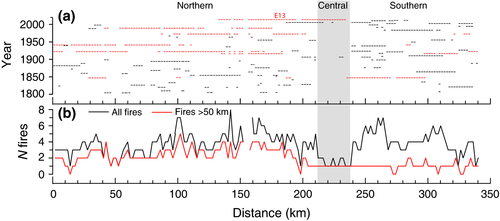
| Northern | Central | Southern | |
|---|---|---|---|
| Total length (km) | 210.2 | 28.0 | 102.0 |
| Total length burned (km) | 789.7 | 40.0 | 420.0 |
| Ratio length burned/zone length | 3.8 | 1.4 | 4.1 |
| Number of fire years | 36 | 4 | 27 |
| Longest fire (km; year) | 118.2; 1922 | 24.0; 2013 | 56.0; 1847 |
| Burn rate 1840–2013 (% land area yr−1) | 2.2 | 0.8 | 2.4 |
| Burn rate 1840–1910 (% land area yr−1) | 1.4 | 0.4 | 2.0 |
| Burn rate 1911–2013 (% land area yr−1) | 2.7 | 1.1 | 2.6 |
Burn rates (percent land area burned per year) were computed for selected time periods and the northern and southern sections by summing all distances burned and dividing by the duration of the time period of interest (the central section was excluded because of its short length and low fire occurrence). Burn rates were also computed by age classes (1–20, 21–40, 41–60, 61–80, >80 years) for the northern and southern sections and for selected time periods. To accomplish this, we divided FI by TSF frequencies within each class, as these values represent the distance (number of cells) that burned for a given age relative to the distance available to burn, respectively (Héon et al., 2014). Confidence intervals of the FI/ TSF ratio were estimated by bootstrapping. For each age class, the FI/TSF ratio was computed 10 000 times from random samples of the original data, and the 95% confidence limits were estimated from the 2.5th and 97.5th percentiles. Burn rates computed from fire lengths are similar to rates computed from the surface area of fire polygons (Héon et al., 2014).
Because wet areas are known to influence fire spread and fire recurrence (Hellberg et al., 2004; Senici et al., 2015), we verified if the number of fire events detected in each cell decreased with increasing abundance of peatlands and lakes in areas surrounding cells. The number of fire recorded in each cell during the 1840–2014 period was compared to the cover of wet areas (lakes plus peatlands) within buffers of 2.5 km from the centroid of cells. Larger buffers were not considered as they imply strong autocorrelation between successive cells. Peatland and lake cover areas were obtained from governmental digital maps at scale 1 : 50 000 (Natural Resource Canada, 2006). We grouped cells by the number of detected fire events (n fires = 1–2, 3–4, 5–6, 7–8) and compared the median cover of wet areas among groups. For each group, the median area was computed 10 000 times from random samples of the original data, and the 95% confidence limits were estimated from the 2.5th and 97.5th percentiles.
Effects of weather and climate on fire spread and length burned were analyzed for two spatiotemporal domains. First, for the northern and southern transect sections, we used superposed epoch analysis along with the gridded CRU TS 3.21 dataset (1901–2012; Harris et al., 2014) to verify whether fire years of the 1901–2012 time period have been characterized by significant anomalies of monthly mean maximum temperature (MTmax), monthly total precipitation (MPcp), and Monthly Drought Code (MDC) for the months of May, June, July, as well as the combination of June and July. More than 95% of the total area burned between 1980 and 2013 in our study region corresponds to fires ignited during these three months. We averaged 36 cells of the CRU dataset between 51° and 54° W and 75.5° and 78.5° N. We performed the analysis separately for large fire years (total length burned ≥10 km; n = 16) and less important fire years (<10 km; n = 16). The MDC, which is computed from MTmax and MPcp, is a monthly version of the Drought Code of the Canadian Fire Weather Index System and is a good predictor of the area burned annually during the last 30–40 years across the Canadian boreal forest (Girardin & Wotton, 2009). Confidence intervals (P = 0.05 and 0.01) of the superposed epoch analysis were determined by bootstrapping.
Second, the 2013 Eastmain fire burned for 5 weeks under an array of weather and landscapes conditions and offered us an exceptional opportunity to examine the bottom-up and top-down controls on the fire as it was developing. We thus compared the map of daily fire progression built from MODIS data (Parks, 2014) with time series of the Canadian Forest Fire Weather Index (FWI) during the 2013 fire season. The FWI combines values of temperature, relative humidity, and wind speed at noon, and 24-h precipitation to evaluate potential fire intensity, with higher values indicating greater fire danger (Van Wagner, 1987). We also examined the entire daily FWI record from the La Grande weather station (1977–2013; n = 6147 days) to verify whether the 2013 fire weather was unprecedented.
Results
Length burned and fire intervals in space and time
High burn rates and large fires have characterized most of the study transect since 1840 (Fig. 3). The overall burn rate was 2.1% of the land area yr−1 for the entire transect over the 1840–2013 time period. In total, fires have intersected the transect over a cumulated length of 1242 km, including 372 km in 1840–1910 (1.1 times the transect length) and 870 km in 1911–2014 (2.6 times the transect length). The ten most important fire years were 1922 (124 km), 2013 (99 km), 1989 (96 km), 1941 (95 km), 1847 (84 km), 1972 (80 km), 1916 (64 km), 2005 (49 km), 1854 (45 km), and 1983 (40 km). Together these major fires intersected 775 km and corresponded to 62.4% of the total length burned since 1840 (Fig. S2). Similarly, fire years with length greater than 10 km (n = 25) intersected 1118 km and corresponded to 90% of the total distance burned.
From 1840 to 2013, a fire occurred on average every 3.5 years somewhere along the transect (Fig. 3a). Considering the entire transect, time intervals between successive fire years varied between 1 year (12 instances) and 10 years (1926–1936). Individual cells have recorded between one and eight fire events and an average of 3.7 ± 1.5 (mean ± SD) fires per cell. Fire-free intervals within individual cells have varied between 2 years (1852–1854 and 1939–1941) and >308 years (1701–2013), this latter value being underestimated due to the absence of fire scars and pine stems across the five corresponding cells (cells 15, 16, 18, 19, 22; Fig. S1). In total, 58% and 26% of the cellwise fire-free intervals that ended after 1840 were shorter than 50 years and 25 years, respectively, and only 10% exceeded 100 years (Fig. S2).
The northern section has experienced much larger fires than the southern section during the 20th century, as reflected in the mapped fire perimeters of the 1980–2013 time period (Fig. 2). Five fire years intersected the road transect over more than 50 km in the northern section after 1920, compared to none in the southern section (Fig. 3b). The large fire years of the 20th century in the northern section were more regularly spaced in time than the shorter fires of the southern section, which were mainly clustered during the 1910–1930 and 1990–2010 time periods (Fig. 4a, b). The largest fire year of the 19th century (1847) occurred mainly in the southern section, this fire being the only one that exceeded 50 km over the entire transect before 1922, suggesting that the two sections have experienced less contrasted fire sizes during the 19th century.
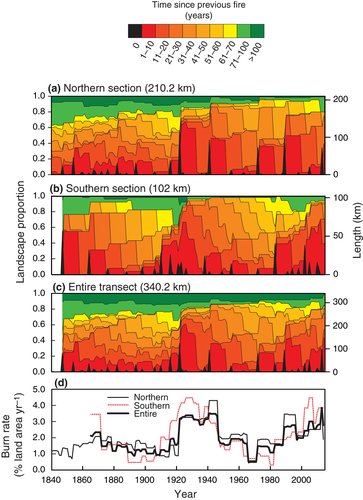
Fire years were mostly asynchronous and length burned annually was not correlated (r = −0.08) between the northern and southern sections (Fig. S3). Of the 50 fire years recorded along the transect, only 12 were common to both the northern and southern sections. Nevertheless, when considering the total distance burned per 25-year time periods, the southern and northern sections have experienced remarkably synchronous trends of high burn rates since 1840, including an abrupt increase from ~1% yr−1 to ~3% yr−1 around 1920, and peaks of ~4% yr−1 around 1940 and 2010 and depressions of ~1% yr−1 around 1910 and 1970, respectively (Fig. 4d). In these two sections, the recent increase in burn rate is thus included within the range of variability of the 1840–2013 time period, although nearing its upper limit. In contrast, the intervening central section has been characterized by an almost complete absence of fire before the 2013 Eastmain fire, which intersected 88% of the section (Fig. 3a). Overall, the central section experienced a mean burn rate of 0.8% yr−1, but this rate fall to 0.3% yr−1 when excluding the 2013 fire.
Climate and weather
At the interannual scale, superposed epoch analysis reveals that large fire years (length burned ≥10 km) are significantly associated with summer temperature and drought anomalies. Large fire years have been characterized by higher June, July, and June–July temperatures and MDC than the preceding or following five years in the northern and southern sections (Fig. 5). In contrast, precipitations anomalies were significantly associated with large fire years only in the northern section for the month of June and June–July (Fig. S4). Less important fire years (length burned <10 km) were characterized by average temperature, precipitation, and drought conditions along the entire transect (Fig. S5).
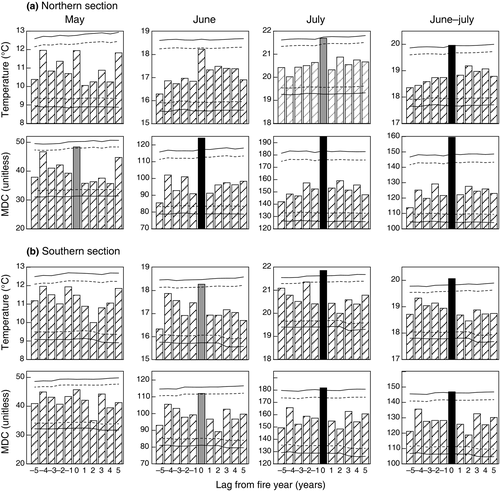
During the 2013 Eastmain fire, extreme daily fire weather, in conjunction with fuel age, was a strong determinant of area burned (Fig. 6). The fire was ignited by lightning on June 9, 2013, and progressively expanded within a large area of forest stands older than 40 years during an episode of moderate-to-high FWI values until July 2. During the last few days of this sequence, the northern border of the fire perimeter was apparently constrained by the adjacent very large 1989 fire (fuels then 24 years of age; Fig. 6b). Subsequently, during July 3–4, the fire grew extremely rapidly (2348 km2 in 48 hrs) under the 8th and 10th most extreme daily FWI values of the 1977–2015 period recorded at the La Grande weather station (Figs 6c and S6). These high FWIs resulted from high temperatures (26–28 °C at noon), as well as strong winds (mean speed of 33 km/hr) and low precipitation during the previous month (34.6 mm since June 5th, as compared to the June normal of 65.3 mm). During these two days, the fire re-burned the 1989 fire to the north, as well as part of the 2005 fire (fuel age: 8 years) to the southeast, and spread across the fire refuge of the central section. The fire was extinguished by rain on July 10 (25 mm recorded at La Grande).

Bottom-up drivers
The strong negative feedback already observed between burn rates and fuel age for the first 193 km of the northern section (Héon et al., 2014) also apply to the southern section (Fig. 7a), despite difference in average fire size, number of fires, and fire years between these two sections. Burn rates progressively increase from about 1.3% yr−1 in forest stands less than 20 years old to more than 5% yr−1 in stands older than 50 years for the period 1910–2014 and 1840–2014 in the northern and southern sections, respectively. However, age-specific burn rates have been higher in young stands (<50 years) of the northern section than the southern section during the 20th century.
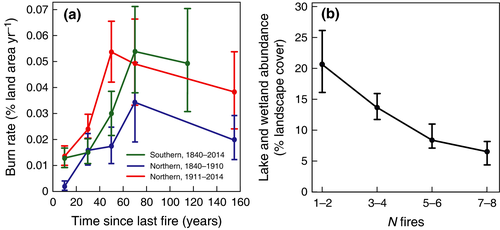
In addition to the bottom-up effect of stand age, the number of fires recorded per cell decreases with increasing wet areas in buffers of 2.5 km around cells (Fig. 7b). Cells surrounded by 5–12% of wet areas tended to experience between 5 and 8 fires, as compared to 1–2 fire events for cells surrounded by 16–26% of wet areas. These latter cells are concentrated into the central section, which cover 8.2% of the total transect length, but contains 42% of all cells that recorded 1–2 fires. In the central section, 100% of all cells recorded 1–2 fires and 2.5-km buffers around cells comprise 24% of wet areas.
Spatiotemporal variability of the stand age mosaic
The forest age mosaic has been highly variable in space and time. Although a high frequency of small fire years maintained a relatively stable age structure in the northern section prior to 1920, large fires every 20–30 years subsequently generated large temporal variations in forest age (Fig. 4a). The northern section was successively dominated (40–60% of the section length) by forest stands aged 1–10 years (in 1930, 1950, 1995), 11–20 years (1935, 1955, 2005), and 21–30 years (1965, 2000). In comparison, the grouping of smaller fires within the 1847–1864, 1910–1930, and 1990–2010 fire episodes in the southern section generated slower age structure fluctuations with age classes of less than 70 years successively peaking every 60–80 years (Fig. 4b).
Even though the study transect was dominated by young forest, with stands <50 years old covering 58.4% ± 8.6% and 76.2% ± 7.4% of the transect length over the 1840–1919 and 1920–2013 time periods, respectively, old-growth forest stands (>100 years old) had persisted in the fire refuge of the central section before the 2013 Eastmain fire (Figs 4c and 8). Indeed, the forest age along the transect for years following the most important fire years indicates that the Eastmain fire shifted the overall age mosaic outside its range of variability of the last 175 years (Fig. 8). The fire almost entirely burned the last remaining old-growth forest patch that had escaped fire in the central section since at least the early 19th century, such that only three cells greater than 100 years old (established after the 1847 fire at km 236–240 and the 1882 fire at km 12–14; 1.8% of the transect length) remain today. Moreover, forest stand older than 70 years are also near their minimum for the last 175 years (currently 15.1% of the transect length vs. minimum of 9.8% in 1973–1976) such that, even with a complete absence of fire, at least 25 years will be needed for the re-emergence of a near-average fraction (10.5%) of forest stands older than 100 years. The longest remaining patch of mid-to-late successional forest is currently 74 years old (established after the 1941 fire) and covers 8.3% of the transect at its northern end (km 0–28).
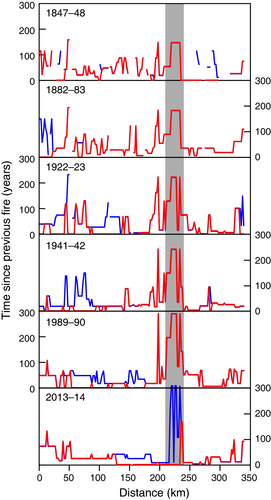
Discussion
Our sampling design allowed the fire activity and associated landscape age mosaic to be reconstructed from direct field evidence within a spatiotemporal domain of 340 km and 174 years, with resolutions of 2 km and one year, respectively. Each fire event detected was explicitly located within this domain, thus allowing the variability of fire lengths and fire intervals, as well as the resulting forest age, to be reconstructed across space and time. Our results indicate that this part of the eastern Canadian taiga has been characterized by an extremely active fire regime and a variable stand age mosaic that has strongly diverged from the age-independent scenario of a randomly structured landscape (Fig. 1). Specifically, previous fires and wet areas strongly control the regional fire activity across space and time such that burning young forests and areas fragmented by wetlands and lakes had to be triggered by severe drought and weather events, as was the case with the exceptional 2013 Eastmain fire. These results help understand and predict the dynamics and impacts of the currently strengthening fire activity in the North American boreal forest.
Structured vs. random age mosaic
Our exhaustive record of fire lengths allowed us to compare fire activity and monthly climate data over a period of 112 years. Anomalies of summer drought severity and high temperatures have been important top-down driver of area burned annually along the entire transect, mainly through their influence on the development of large fires (i.e., fire length greater than 10 km), which accounted for 90% of the total distance burned during the last 175 years. This dominant role of temperatures and drought in our study area is coherent with most studies of fire activity in the North American boreal forest, although the relative influence of these two factors varies among regions (Duffy et al., 2005; Flannigan et al., 2005; Balshi et al., 2009; Parisien et al., 2011; Ali et al., 2012; Boulanger et al., 2013). Moreover, despite asynchronous fire years between the northern and southern sections of the transect, drought and temperature anomalies most likely synchronized interdecadal trends fire of activity at the regional scale (Gavin et al., 2006), as both sections experienced synchronous decadal burn rates and a similar influence of temperature and drought on large fires. Ultimately, this synchronizing top-down influence may have been forced by large-scale climate patterns driven by oceanic temperatures (Girardin et al., 2004; Le Goff et al., 2007).
Despite the strong link between monthly climate and annual area burned, wildfire spread is in fact largely driven by day-to-day variation in weather following ignition (Abatzoglou & Kolden, 2011). For example, the 2013 Eastmain fire, which is the second-largest fire of our dataset, shows how a few days of extreme fire weather, characterized by strong winds and high temperatures had a disproportionate influence on area burned. In its early phase, the Eastmain fire progressively expanded across a large area of mature forest stands under relatively sustained severe fire weather and then spread very rapidly across any fuel types during two consecutive days of extremely severe fire weather conditions. Such extreme conditions probably contributed also to the spread of the largest fire of our dataset (1922 fire; 124 km), as suggested by its 50-km overlap with the 1917 fire (fuel then aged 5 years) at km 135–185 (Fig. 3). Flat topography and prevailing winds parallel to rivers and landscape orientation (east-west) may have amplified the effect of weather during the development of these very large fires (Mansuy et al., 2014).
Despite strong top-down influences of climate and weather, our study area is clearly an age-dependent stand age mosaic (Fig. 1; Héon et al., 2014; Parisien et al., 2014; Parks et al., 2015, 2016). In fact, the burn rate of 5.5% yr−1 in forest stands older than 50 years during the 20th century, compared to rates of 0–1.5% yr−1 in stands of less than 20 years old (Fig. 7a), indicates that the age-dependent resistance to fire activity is considerable and that an extremely high burn rates of ~5% yr−1 would have characterized our study region during the last century in the absence of a fuel age effect. An overall burn rate of 5% yr−1 would have been almost two times greater than the highest rates recently observed within the most fire-prone areas of the Canadian boreal zone (Boulanger et al., 2012). Although it has long been assumed that fires occur independently of forest age in the North American boreal forest (Bessie & Johnson, 1995), our results clearly show that this is not always the case.
Several phenomena can explain the strength of age-dependent resistance to fire. First, because of its high burn rate relative to the rate of postfire fuel recovery, our study area has been characterized by frequent encounter of immature fuels by spreading fires, thus increasing the strength of the age effect as compared to other regions of the North American boreal forest where no such effect was detected (Price et al., 2015). Second, although almost any fuel type can burn during extreme fire weather, as shown in the Eastmain fire and elsewhere in North America (Parks et al., 2015), such extreme conditions are rare by definition and do not occur during all fires or through the entire growth of a given fire event. For example, the extraordinarily rapid growth observed during the last stage of the Eastmain fire was triggered by one of the two sequences of two consecutive days with a FWI index value greater than 50 to have occurred since 1977 in the study area. Third, age-independent fire progression during extreme weather is in fact spatially dependent on prior age-dependent growth of the same fire during less extreme weather, as also evidenced by the early progression of the Eastmain fire (Fig. 6a). That a fire perimeter of more than 150 km was already active at the onset of the final sequence in 2013 permitted considerable fire growth during the following two days. Fourth, compared to other fuel types, the flammability of mature conifers increases disproportionately with elevated temperature and drought, leading to the preferential development of large fires within large patches of mature conifers (Bernier et al., 2016; Dash et al., 2016). Fifth, fuel age is likely to influence not only fire spread but also ignition (Krawchuk et al., 2006). Finally, because fire is a spatially contagious phenomenon, fire-resistant landscape patches will not only reduce fire activity within their interior, but also outside their boundaries, creating a ‘fire shadow’ (Finney, 2005; Parisien et al., 2010).
In addition to the transient effect of forest age on landscape-level flammability, lakes and large peatlands represent additional bottom-up impediments to fire ignition and spread. Increasing lake and peatland abundance at distances of at least 2.5 km has considerably reduced fire recurrence within sampling cells (Fig. 7b). This effect has been most evident in the central section before the 2013 fire, demonstrating that large sectors can escape fire repeatedly, even within the most fire-prone regions of the boreal forest. It is well known that individual sites may escape fire (Wallenius et al., 2004; Cyr et al., 2005; Ouarmim et al., 2015) due to poor drainage conditions and high lake or wetland abundance in their surroundings (Hellberg et al., 2004; Cyr et al., 2005; Madoui et al., 2011; Barrett et al., 2013; Senici et al., 2015). These fire refuges, with their associated biodiversity and high carbon stocks are important features of these landscapes (Hornberg et al., 1998; Ouarmim et al., 2014). In our study area, the lack of fire eventually leads to jack pine exclusion and to the development of overmature spruce stands (LeGoff & Sirois, 2004).
Because lakes and peatlands tend to promote the persistence of old forest stands, whereas stand age per se has the opposite effect, these two resistance mechanisms would have tended to mask each other's effect in our dataset. Thus, a stronger age dependence of burn rates may have been documented in the absence of lakes and peatlands and a stronger wet area dependence may have been detected in the absence of stand age effect. For example, the apparent decrease in burn rates in forest stands more than 60 years old (Fig. 7a) probably reflects the tendency of these old stands to develop and persist in areas resistant to fire due to high lake and peatland cover. The alternative explanation that overmature spruce stands decrease in flammability is not supported by recent studies showing that these stands are positively selected by fire across the North American boreal forest (Bernier et al., 2016; Dash et al., 2016).
Although interactions among lake and peatlands and stand age are probably spatially complex, collectively these factors would help identify areas at greater risk of burning (e.g., large forest patch more than 50 years old containing few lakes and peatlands), as well as infrastructure exposure to fire in the current context of increasing fire activity. For example, the large sector that has escaped fire for several decades in the surroundings of the La Grande weather station at the northern end of the transect (Fig. 2) corresponds to an unusually persistent large area of old forests in the context of the last century (km 0–50 in Figs 3 and 8) and comprises several strategic hydroelectric infrastructures along with the towns of Chisasibi, Wemindji, and Radisson. Burn probability modeling using fire growth algorithms would help map fire likelihood around infrastructures, given the surrounding land physiography, hydrography, and fuel types (Finney, 2005; Parisien et al., 2007).
Spatiotemporal variability vs. recent and future trends
Our study supports previous assertions that regions experiencing very large fires have inherently unstable fire regimes because fires are so large that no fraction of the total landscape can represent its entirety; that is, no section comprises the same age classes frequency distribution as the total landscape (Romme, 1982; Baker, 1989; Turner et al., 1993). Although a relatively stable age mosaic prevailed in the northern section of the study area during the 19th century due to relatively small and regular fire events, large and irregular fires in the rest of our spatiotemporal domain clearly resulted in an unstable, oscillating landscape age mosaic.
Consequently, because of high background variability, along with buffering of burn rates by bottom-up resistance, long records of fire size, fire intervals, and burn rates are necessary to determine whether the recent warming trend has shifted the fire regime outside its range of variability. For instance, even though it may be fairly exhaustive, the atlas of fire perimeters in Canada (1980–2013; Fig. 2) is too short to provide an adequate reference period. In addition, the increase in burn rates with temperatures may be altered by the confounding influence of precipitation and drought (Girardin & Mudelsee, 2008). For example, although a rising trend of burn rates is evident in our study area (1980–2012), a similar interval of high burn rates occurred during the early 20th century during a time period of relatively cold summer temperatures (Gennaretti et al., 2014; Naulier et al., 2015). Thus, even if recent burn rates of the study area have been rising to relatively high values compared to the rest of the North American boreal forest, this trend would have to continue for a few additional decades before we could confirm that recent warming has led to unprecedented burn rates.
However, by simultaneously considering the spatial and temporal dimensions, our study suggests that the forest age mosaic may be outside its range of variability even if the main fire regime parameters (fire size, fire intervals, burn rates) are not. By allowing the 2013 fire to spread into an area previously resistant to fire due to its high lake and peatland cover, extremely severe fire weather has shifted the abundance of fire refuge outside its range of variability of the last 175 years (Fig. 8). Because large patches of old forest stands are unlikely to develop in these fire-prone regions without the sheltering effect of lakes and peatlands, they may be vulnerable to such severe weather. The directional erosion of these fire refuges at large spatial scale (ecological region, province, biome) would be an early sign that new fire regimes and age mosaic are developing.
Future burn rates will continue to diverge from rates predicted based solely on climatic potential, although the intensity of this phenomenon is likely to vary with climate change. The predicted increase in the frequency of severe fire weather (Jolly et al., 2015; Wang et al., 2015) is likely to weaken the age-dependent resistance to high burn rates. This is demonstrated by the abrupt progression of the Eastmain fire, as well as by the higher age-specific burn rates we observed when fire of the northern section was immense. It will be interesting to determine whether the extreme conditions that characterized the last few days of 2013 Eastmain fire are increasing in frequency and, if so, how this may affect burn rates and the predictability of the boreal landscape.
Acknowledgements
The authors wish to thank Pierre-Paul Dion and Simon Williams for field and laboratory assistance and two reviewers for their constructive comments. This research was financially supported by NSERC, Hydro-Quebec, Ouranos, ArcticNet, the EnviroNorth training program, and the Centre for Northern Studies.



